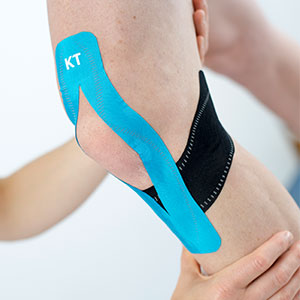
What is Kinesio Therapy?
The Kinesio Taping® Method is a definitive rehabilitative taping technique that is designed to facilitate the body’s natural healing process while providing support and stability to muscles and joints without restricting the body’s range of motion.
It involves placing strips of special tape on your body in specific directions to help improve your mobility and support your joints, muscles and tendons.
Background
Kinesiology tape was developed in the 1970’s by a chiropractor named Dr Kenso Kase, DC. He found that using a flexible tape that harnessed the interface between the skin and the muscles could provide long-lasting effects for his patients. He developed many of the techniques used in kinesiology taping today, and he also has his brand of tape called Kinesiotape.
What it does
The Kinesio® Taping Method is a therapeutic taping technique not only offering you the support you are looking for, but also rehabilitating the affected condition as well. By targeting different receptors within the somatosensory system, Kinesio® Tex Tape alleviates pain and facilitates lymphatic drainage by microscopically lifting the skin. This lifting affect forms convolutions in the skin thus increasing interstitial space and allowing for a decrease in inflammation of the affected areas.
Specific Uses
There are many different uses for kinesiology tape. Some common uses of kinesiology tape include:
Facilitation: Kinesiology tape can be used to help improve muscular firing and contraction patterns. This can lead to normalized muscular tone and can also help improve athletic performance.
Inhibition and pain management: Kinesiology tape can be used to help decrease pain and muscle spasm that may occur after injury. It can help decrease nociceptive input to the brain which can help decrease muscle guarding and protective spasm.
Support and stability: If you have a condition that requires a specific joint to be held in place, kinesiology taping may be right for you. Conditions like patellofemoral stress syndrome, iliotibial band friction syndrome, or shoulder instability may benefit from extra support provided by kinesiology tape. The tape can support your joint while still allowing for some motion to occur.
Swelling management: If you have suffered an injury or have had surgery that results in increased swelling, kinesiology tape may help to decrease the swelling by decreasing pressure between the skin and underlying tissues. This provides a pathway for excess fluids that have accumulated since your injury to travel through. Kinesiology tape is sometimes used in lymphedema management or for superficial contusions.
Scar tissue management: After surgery or trauma, you may have a scar over the area that was injured. Sometimes the tissue underneath the scar binds to your skin and underlying fascia. This scar tissue can limit your normal mobility and range of motion. Kinesiology tape can be used to gently pull on scar tissue, providing a low intensity, long duration stretch to the tight collagen that makes up scar tissue.






